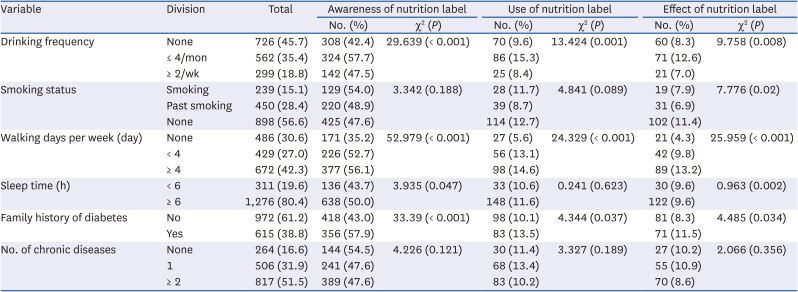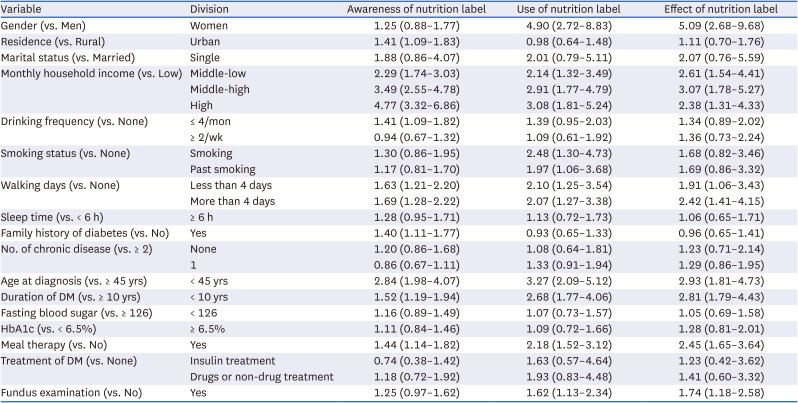1. Choi YJ, Kim HC, Kim HM, Park SW, Kim J, Kim DJ. Prevalence and management of diabetes in Korean adults: Korea National Health and Nutrition Examination Surveys 1998-2005. Diabetes Care. 2009; 32:2016–2020. PMID:
19675201.
2. Ministry of Health and Welfare (KR). Korea Center for Disease Control and Prevention. Korea Health Statistics 2019: Korea National Health and Nutrition Examination Survey (KNHANES VIII-1). Cheongju: Korea Center for Disease Control and Prevention;2020.
4. International Diabetes Federation. Diabetes around the world in 2021 [Internet]. Brussels: International Diabetes Federation;2021. cited 2022 January 28. Available from:
https://diabetesatlas.org/.
5. International Diabetes Federation. Recommendations for managing type 2 diabetes in primary care [Internet]. Brussels: International Diabetes Federation;2017. cited 2022 January 28. Available from:
www.idf.org/managing-type2-diabetes.
6. Breen C, Ryan M, Gibney MJ, O’Shea D. Diabetes-related nutrition knowledge and dietary intake among adults with type 2 diabetes. Br J Nutr. 2015; 114:439–447. PMID:
26169113.
7. Silverglade BA. The nutrition labeling and education act—progress to date and challenges for the future. J Public Policy Mark. 1996; 15:148–150.
8. Kang HN, Shin EJ, Kim HN, Eom KY, Kwon KI, Kim SY, Moon GI, Kang BW, Kim JW. Food nutrition labeling (processing food, food service business) in Korea. Food Sci Ind. 2011; 44:21–27.
9. An R, Shi Y, Shen J, Bullard T, Liu G, Yang Q, Chen N, Cao L. Effect of front-of-package nutrition labeling on food purchases: a systematic review. Public Health. 2021; 191:59–67. PMID:
33517247.
10. Neuhouser ML, Kristal AR, Patterson RE. Use of food nutrition labels is associated with lower fat intake. J Am Diet Assoc. 1999; 99:45–53. PMID:
9917731.
11. Navarrete-Muñoz EM, Torres-Collado L, Valera-Gran D, Gonzalez-Palacios S, María Compañ-Gabucio L, Hernández-Sánchez S, García-de-la-Hera M. Nutrition labelling use and higher adherence to Mediterranean diet: results from the DiSA-UMH study. Nutrients. 2018; 10:442. PMID:
29614009.
12. Emrich TE, Qi Y, Lou WY, L’Abbe MR. Traffic-light labels could reduce population intakes of calories, total fat, saturated fat, and sodium. PLoS One. 2017; 12:e0171188. PMID:
28182630.
13. Park SG, Kim HJ, Kwon YM, Kong MH. Nutrition label use and its relation to dietary intake among chronic disease patients in Korea: results from the 2008-2009 Fourth Korean National Health and Nutrition Examination Survey (KNHANES-IV). Korean J Health Promot. 2014; 14:131–140.
14. An R. Diabetes diagnosis and nutrition facts label use among US adults, 2005-2010. Public Health Nutr. 2016; 19:2149–2156. PMID:
26483168.
15. Elfassy T, Yi S, Eisenhower D, Lederer A, Curtis CJ. Use of sodium information on the nutrition facts label in New York City adults with hypertension. J Acad Nutr Diet. 2015; 115:278–283. PMID:
25441962.
16. Kang HT, Shim JY, Lee YJ, Linton JA, Park BJ, Lee HR. Reading nutrition labels is associated with a lower risk of metabolic syndrome in Korean adults: the 2007-2008 Korean NHANES. Nutr Metab Cardiovasc Dis. 2013; 23:876–882. PMID:
23146359.
17. Kweon S, Kim Y, Jang MJ, Kim Y, Kim K, Choi S, Chun C, Khang YH, Oh K. Data resource profile: the Korea National Health and Nutrition Examination Survey (KNHANES). Int J Epidemiol. 2014; 43:69–77. PMID:
24585853.
18. Lee YH, Bang H, Kim HC, Kim HM, Park SW, Kim DJ. A simple screening score for diabetes for the Korean population: development, validation, and comparison with other scores. Diabetes Care. 2012; 35:1723–1730. PMID:
22688547.
19. Hippisley-Cox J, Coupland C, Vinogradova Y, Robson J, May M, Brindle P. Derivation and validation of QRISK, a new cardiovascular disease risk score for the United Kingdom: prospective open cohort study. BMJ. 2007; 335:136. PMID:
17615182.
20. Post RE, Mainous AG 3rd, Diaz VA, Matheson EM, Everett CJ. Use of the nutrition facts label in chronic disease management: results from the National Health and Nutrition Examination Survey. J Am Diet Assoc. 2010; 110:628–632. PMID:
20338291.
21. Sonnenberg L, Gelsomin E, Levy DE, Riis J, Barraclough S, Thorndike AN. A traffic light food labeling intervention increases consumer awareness of health and healthy choices at the point-of-purchase. Prev Med. 2013; 57:253–257. PMID:
23859926.
22. Park HK. Nutrition policy for nutrition labeling in Korea. Food Ind Nutr. 2009; 14:9–14.
23. Velardo S. The nuances of health literacy, nutrition literacy, and food literacy. J Nutr Educ Behav. 2015; 47:385–389.e1. PMID:
26026651.
24. Mansfield E, Wahba R, De Grandpré E. Integrating a health literacy lens into nutrition labelling policy in Canada. Int J Environ Res Public Health. 2020; 17:4130. PMID:
32531887.
25. Hong SW, Oh SW, Lee C, Kwon H, Hyeon JH, Gwak JS. Association between nutrition label use and chronic disease in Korean adults: the Fourth Korea National Health and Nutrition Examination Survey 2008-2009. J Korean Med Sci. 2014; 29:1457–1463. PMID:
25408575.
26. Chung JY, Kim MJ. Using and understanding of nutrition labels and related factors among female adults in the Seoul area. Korean J Community Nutr. 2007; 12:417–425.
27. Kim MH. Metabolic risk and nutrient intake by nutrition education in Korean adult men-result from the 2016~2017 Korea National Health and Nutrition Examination Survey. Korean J Food Nutr. 2019; 32:251–258.
28. Rothman RL, Housam R, Weiss H, Davis D, Gregory R, Gebretsadik T, Shintani A, Elasy TA. Patient understanding of food labels: the role of literacy and numeracy. Am J Prev Med. 2006; 31:391–398. PMID:
17046410.
29. Jo HS, Jung SM. Evaluation of food labeling policy in Korea: analyzing the community health survey 2014-2017. J Korean Med Sci. 2019; 34:e211. PMID:
31432651.
30. Burns C, Cook K, Mavoa H. Role of expendable income and price in food choice by low income families. Appetite. 2013; 71:209–217. PMID:
24008182.
31. Lo YT, Chang YH, Lee MS, Wahlqvist ML. Health and nutrition economics: diet costs are associated with diet quality. Asia Pac J Clin Nutr. 2009; 18:598–604. PMID:
19965354.
32. Berrigan D, Dodd K, Troiano RP, Krebs-Smith SM, Barbash RB. Patterns of health behavior in U.S. adults. Prev Med. 2003; 36:615–623. PMID:
12689807.
33. Zoungas S, Woodward M, Li Q, Cooper ME, Hamet P, Harrap S, Heller S, Marre M, Patel A, Poulter N, et al. Impact of age, age at diagnosis and duration of diabetes on the risk of macrovascular and microvascular complications and death in type 2 diabetes. Diabetologia. 2014; 57:2465–2474. PMID:
25226881.
34. Nanayakkara N, Ranasinha S, Gadowski A, Heritier S, Flack JR, Wischer N, Wong J, Zoungas S. Age, age at diagnosis and diabetes duration are all associated with vascular complications in type 2 diabetes. J Diabetes Complications. 2018; 32:279–290. PMID:
29352694.
35. Tapp RJ, Zimmet PZ, Harper CA, de Courten MP, Balkau B, McCarty DJ, Taylor HR, Welborn TA, Shaw JE. Australian Diabetes Obesity and Lifestyle Study Group. Diabetes care in an Australian population: frequency of screening examinations for eye and foot complications of diabetes. Diabetes Care. 2004; 27:688–693. PMID:
14988286.
36. O’Keeffe D, Riordan F, Harkins V, Kearney P, Mc Hugh S. Predictors of attendance at diabetic retinopathy screening among people with type 2 diabetes: secondary analysis of data from primary care. Prim Care Diabetes. 2021; 15:1086–1094. PMID:
34518110.
37. Lewis JE, Arheart KL, LeBlanc WG, Fleming LE, Lee DJ, Davila EP, Cabán-Martinez AJ, Dietz NA, McCollister KE, Bandiera FC, et al. Food label use and awareness of nutritional information and recommendations among persons with chronic disease. Am J Clin Nutr. 2009; 90:1351–1357. PMID:
19776144.
38. Chae HW, Seo GH, Song K, Choi HS, Suh J, Kwon A, Ha S, Kim HS. Incidence and prevalence of type 1 diabetes mellitus among Korean children and adolescents between 2007 and 2017: an epidemiologic study based on a national database. Diabetes Metab J. 2020; 44:866–874. PMID:
33142054.








 PDF
PDF Citation
Citation Print
Print



 XML Download
XML Download